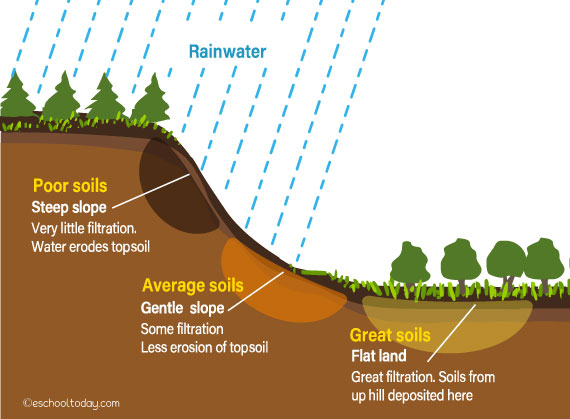- Soils
Factors Affecting Soil Formation
Soils form from the interplay of five main factors namely Parent Material, Time, Climate, Relief, and Organisms.
Parent material:
It refers to the mineral material or organic material from which the soil is formed. The soil will carry the characteristics of its parent material such as color, texture, structure, mineral composition, and so on. For example, if soils are formed from an area with large rocks (parent rocks) of red sandstone, the soils will also be red and have the same feel as its parent material.
Time:
Soils can take many years to form. Younger soils have some characteristics from their parent material, but as they age, the addition of organic matter, exposure to moisture, and other environmental factors may change their features. With time, they settle and are buried deeper below the surface, taking time to transform. Eventually, they may change from one soil type to another.
Climate:
This is probably the most important factor that can shape the formation of soils. Two important climatic components, temperature, and precipitation are key. They determine how quickly weathering will be and what kind of organic materials may be available on and inside of the soils. Moisture determines the chemical and biological reactions that will occur as the soils are formed. A warmer climate with more rainfall means more vegetative cover and more animal action. It also means more runoff, more percolation, and more water erosion. They all help to determine the kind of soil in an area.
Relief:

This refers to the landscape position and the slopes it has. Steep, long slopes mean water will run down faster and potentially erode the surfaces of slopes. The effect will be poor soils on the slopes and richer deposits at the foot of the slopes. Also, slopes may be exposed to more direct sunlight, which may dry out soil moisture and render it less fertile.
Organisms:
The source and richness of organic matter are down to the living things (plants and animals) that live on the surface and inside the soils. Plants, in particular, provide lots of vegetative residues that are added to soils. Their roots also hold the soils and protect them from wind and water erosion. They shelter the soils from the sun and other environmental conditions, helping the soils to retain the needed moisture for chemical and biological reactions. Fungi, bacteria, insects, earthworms, and burrowing animals help with soil aeration. Worms help break down organic matter and aid decomposition. Animal droppings, dead insects, and animals result in additional decaying organic matter. Microorganisms also help with mineral and nutrient cycling and chemical reactions.
